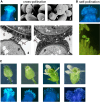Stop and go signals at the stigma-pollen interface of the Brassicaceae
- PMID: 37423711
- PMCID: PMC10517188
- DOI: 10.1093/plphys/kiad301
Stop and go signals at the stigma-pollen interface of the Brassicaceae
Erratum in
-
Correction to: Stop and go signals at the stigma-pollen interface of the Brassicaceae.Plant Physiol. 2024 Jul 31;195(4):3138. doi: 10.1093/plphys/kiae242. Plant Physiol. 2024. PMID: 38717872 Free PMC article. No abstract available.
Conflict of interest statement
Conflict of interest statement. None declared.
Figures





Similar articles
-
The ARC1 E3 ligase gene is frequently deleted in self-compatible Brassicaceae species and has a conserved role in Arabidopsis lyrata self-pollen rejection.Plant Cell. 2012 Nov;24(11):4607-20. doi: 10.1105/tpc.112.104943. Epub 2012 Nov 30. Plant Cell. 2012. PMID: 23204404 Free PMC article.
-
Pollen wall degradation in the Brassicaceae permits cell emergence after pollination.Am J Bot. 2017 Aug;104(8):1266-1273. doi: 10.3732/ajb.1700201. Am J Bot. 2017. PMID: 29756225
-
High humidity partially rescues the Arabidopsis thaliana exo70A1 stigmatic defect for accepting compatible pollen.Plant Reprod. 2014 Sep;27(3):121-7. doi: 10.1007/s00497-014-0245-z. Epub 2014 Jun 29. Plant Reprod. 2014. PMID: 24973977
-
Exocyst, exosomes, and autophagy in the regulation of Brassicaceae pollen-stigma interactions.J Exp Bot. 2017 Dec 18;69(1):69-78. doi: 10.1093/jxb/erx340. J Exp Bot. 2017. PMID: 29036428 Review.
-
Pollen Acceptance or Rejection: A Tale of Two Pathways.Trends Plant Sci. 2016 Dec;21(12):1058-1067. doi: 10.1016/j.tplants.2016.09.004. Epub 2016 Nov 11. Trends Plant Sci. 2016. PMID: 27773670 Review.
Cited by
-
From gametes to zygote: Mechanistic advances and emerging possibilities in plant reproduction.Plant Physiol. 2024 Apr 30;195(1):4-35. doi: 10.1093/plphys/kiae125. Plant Physiol. 2024. PMID: 38431529 Free PMC article. Review. No abstract available.
-
Molecular mechanisms and genetic regulation of self-incompatibility in flowering plants: implications for crop improvement and evolutionary biology.Plant Mol Biol. 2025 Jun 25;115(4):76. doi: 10.1007/s11103-025-01610-9. Plant Mol Biol. 2025. PMID: 40560319 Review.
-
Insights into the Molecular Basis of Pollen Coat Development and Its Role in Male Sterility.Int J Mol Sci. 2025 Jul 22;26(15):7036. doi: 10.3390/ijms26157036. Int J Mol Sci. 2025. PMID: 40806169 Free PMC article. Review.
-
A pollen selection system links self and interspecific incompatibility in the Brassicaceae.Nat Ecol Evol. 2024 Jun;8(6):1129-1139. doi: 10.1038/s41559-024-02399-4. Epub 2024 Apr 18. Nat Ecol Evol. 2024. PMID: 38637692
-
Ac-DEVD-CHO (caspase-3/DEVDase inhibitor) suppresses self-incompatibility-induced programmed cell death in the pollen tubes of petunia (Petunia hybrida E. Vilm.).Cell Death Discov. 2024 Jan 30;10(1):59. doi: 10.1038/s41420-024-01821-x. Cell Death Discov. 2024. PMID: 38287001 Free PMC article.
References
-
- Bateman AJ. Self-incompatibility systems in angiosperms. III. Cruciferae. Heredity. 1955:9(1):53–68. 10.1038/hdy.1955.2 - DOI
Publication types
MeSH terms
LinkOut - more resources
Full Text Sources

